Strangler fig
Strangler fig is the common name for a number of tropical and subtropical plant species, including some banyans and unrelated vines, including among many other species:
- Ficus aurea, also known as the Florida strangler fig
- Ficus benghalensis
- Ficus burtt-davyi
- Ficus citrifolia
- Ficus craterostoma
- Ficus tinctoria
- Ficus macrophylla
- Ficus obliqua
- Ficus virens
- Ficus watkinsiana
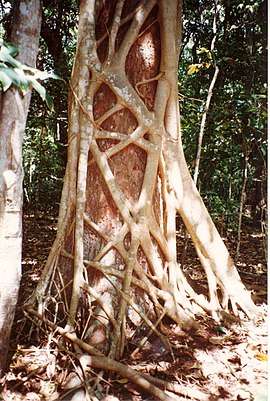
These all share a common "strangling" growth habit that is found in many tropical forest species, particularly of the genus Ficus.[1] This growth habit is an adaptation for growing in dark forests where the competition for light is intense. These plants are hemiepiphytes, spending the first part of their life without rooting into the ground. Their seeds, often bird-dispersed, germinate in crevices atop other trees. These seedlings grow their roots downward and envelop the host tree while also growing upward to reach into the sunlight zone above the canopy.[2][3]
An original support tree can sometimes die, so that the strangler fig becomes a "columnar tree" with a hollow central core.[4] However, it is also believed that the strangler fig can help the support tree survive storms.[5]
Gallery
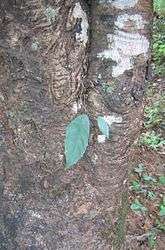 A strangler fig sapling starts to grow on a tree. Roots can be seen
A strangler fig sapling starts to grow on a tree. Roots can be seen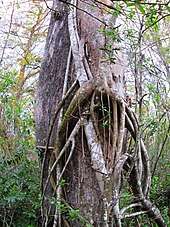 The trunk of a bald cypress, surrounded by the roots of a strangler fig
The trunk of a bald cypress, surrounded by the roots of a strangler fig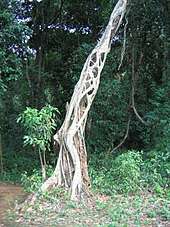 A strangler fig. The supporting tree, now dead, can also be seen. Photo from Kannavam forest
A strangler fig. The supporting tree, now dead, can also be seen. Photo from Kannavam forest
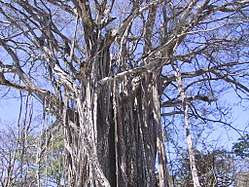 Old strangler fig in the final stage, Costa-Rica, Pacific
Old strangler fig in the final stage, Costa-Rica, Pacific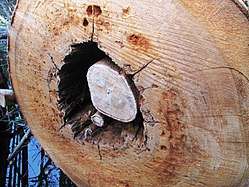 A cross section of a bald cypress at the Corkscrew Swamp Sanctuary, showing the roots of a strangler fig inside of it
A cross section of a bald cypress at the Corkscrew Swamp Sanctuary, showing the roots of a strangler fig inside of it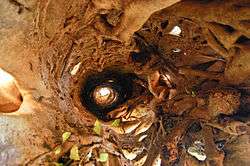 A columnar tree formed by a strangler fig after the central tree has died. The tree is hollow as seen in this photograph from below.
A columnar tree formed by a strangler fig after the central tree has died. The tree is hollow as seen in this photograph from below.
References
- Zhekun, Zhou & Michael G. Gilbert (2003) "Flora of China" (Moraceae) 5: 21–73. hua.huh.harvard.edu Archived 2006-09-01 at the Wayback Machine
- Serventy, V. (1984). Australian Native Plants. Victoria: Reed Books.
- "Light in the rainforest" 1992 Tropical topics. Vol 1 No. 5, epa.qld.gov.au Archived 2007-07-01 at the Wayback Machine
- Margaret Lowman; H. Bruce Rinker (2004). Forest Canopies. Academic Press. pp. 180–. ISBN 978-0-12-457553-0.
- Richard, Leora.; Halkin, Sylvia (June 2017). "Strangler figs may support their host trees during severe storms". Symbiosis. 72 (2): 153–157. doi:10.1007/s13199-017-0484-5.
External links
| Wikimedia Commons has media related to Strangler figs. |
- The Tropical Rain Forest, including photos of strangler figs
- The Queen of Trees: Fig Trees – From the Sacred to the Strangler
- Being strangled may save this tree’s life